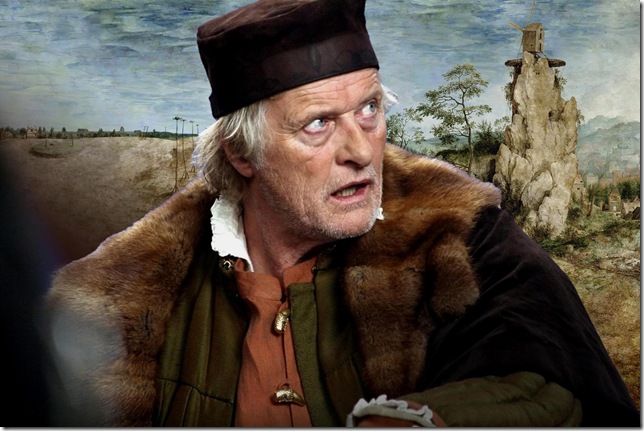Film adaptations of plays, books and even video games are as common as rain in Seattle, but a movie adaptation of a painting? That’s an undertaking so ambitious – and probably presumptuous – that it’s hard to fathom it. Polish director Lech Majewski is up to the task in The Mill and the Cross, attempting to delve beyond the canvas of Pieter Bruegel the Elder’s famous The Way to Cavalry.
The movie’s single-shot prologue beautifully organizes its concept: Bruegel (Rutger Hauer) walks through a multi-dimensional landscape of human figures frozen in time, Last Year at Marienbad-style. These are his painted subjects in The Way to Cavalry, and in a performance of pure pensiveness, Hauer will exhibit an almost invisible control over them, like a conductor organizing a symphony or a film director supervising a production.
Majewski’s camera tracks slowly across the tableau, like the eyes of a museum spectator might do along a wall-length fresco. It’s a sequence that would play spectacularly in 3D but, like the preamble of Melancholia, it’s also the movie’s artistic zenith, having nowhere to go but down.
Most of The Mill and the Cross is presented without dialogue. Only Hauer, Michael York (as Nicolaes Jonghelinck, a wealthy patron of Bruegel’s) and Charlotte Rampling (as the Virgin Mary, convincingly expressing grief and suffering even in the thinnest of roles) have speaking parts, even though most of the action takes place in the landscape of Bruegel’s mind – specifically Flanders in 1564 (when Bruegel actually lived), where red-tunicked Spanish occupiers raid, pillage and crucify to their heart’s content.
Much of the “plot” is an experiential and ethnographic study of a village; children frolic, animals meander, musicians play folksongs, a horny man pursues a woman who fights off his advances until she doesn’t. When the Spaniards invade, they bring savagery to the bucolic land. Flagellation, living burials and the inevitable crucifixion of Christ are presented with matter-of-fact realism, and it couldn’t be a farther cry from Mel Gibson’s Passion movie, or even Scorsese’s or Pasolini’s. I would go so far as to say The Mill and the Cross is 2011’s least manipulative film.
In this case, such detachment brings with it a paucity of emotional connection. There’s no denying the power of Majewski’s images, most of which are imbued with a painter’s scope and precision. The film was shot in four countries and even includes a 2D rendering of The Way to Cavalry painted by the director. Ordinary objects are filmed with reverence and resplendence.
But these are surface pleasures. Absent anything like character-building, the film generates no compassion toward its victims and inspires no hatred for its marauders. As choreographed by Bruegel’s hand, it’s a bloodlessly subjective history lesson. What’s worse, Majewski’s screenplay (co-written with Michael Francis Gibson) is ponderously dense. The mill in the painting isn’t just a mill, we’re told; it’s “the axis around which people circle between life and death,” an admission that comes off like a bit of Cliff’s Notes embedded into a text.
But that’s just the beginning of this spiritual decoder ring of a movie, whose procession of symbols suggest that its target demographic is semioticians, not movie audiences. The film’s portent knows no end, and it has an awfully inflated sense of its own self-worth.
Throughout the running time, my mind drifted to a 2007 episode of Showtime’s This American Life, in which an artist attempted to create a live-action tableau of Christ and his companions, which he would then paint as part of a mural series. This half-hour study of the creation of a painting was far less ambitious than The Mill in the Cross, but it was ultimately richer and, it goes without saying, infinitely more entertaining.
THE MILL AND THE CROSS. Director: Lech Majewski; Cast: Rutger Hauer, Michael York, Charlotte Rampling; Distributor: Kino Lorber; Opens: Friday at Lake Worth Playhouse, Mos’ Art Theatre, Miami Beach Cinematheque and Bill Cosford Cinema in Coral Gables.
